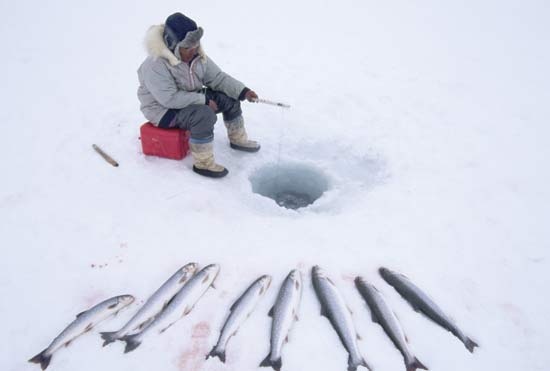Eskimo
people
 any member of a group of peoples who, with the closely related Aleuts, constitute the chief element in the indigenous population of the Arctic and subarctic regions of Greenland, Canada, the United States, and far eastern Russia (Siberia).
any member of a group of peoples who, with the closely related Aleuts, constitute the chief element in the indigenous population of the Arctic and subarctic regions of Greenland, Canada, the United States, and far eastern Russia (Siberia).The self-designations of Eskimo peoples vary with their languages and dialects. They include such names as , Inupiat, Yupik, and Alutiit, each of which is a regional variant meaning “the people” or “the real people.” The name Eskimo, which has been applied to Arctic peoples by Europeans and others since the 16th century, originated with the Innu (Montagnais), a group of Algonquian speakers; once erroneously thought to mean “eaters of raw flesh,” the name is now believed to make reference to snowshoes.
One of the oldest known Eskimo archaeological sites was found on Saglek Bay, Labrador, and dates to approximately 3,800 years ago. Another was found on Umnak Island in the Aleutians, for which an age of approximately 3,000 years was recorded.
Eskimo people are culturally and biologically distinguishable from neighbouring indigenous groups including American Indians (American Indian) and the Sami of northern Europe. Studies comparing Eskimo-Aleut languages to other indigenous North American languages indicate that the former arose separately from the latter. Physiologically, an appreciable percentage of Eskimo people have the B blood type (ABO system (ABO blood group system)), which seems to be absent from other indigenous American groups. Because blood type is a very stable hereditary trait, it is believed that at least a part of the Eskimo population is of a different origin from other indigenous American peoples.
 Culturally, traditional Eskimo life was totally adapted to an extremely cold, snow- and icebound environment in which vegetable foods were almost nonexistent, trees were scarce, and caribou, seal, walrus, and whale meat, whale blubber, and fish were the major food sources. Eskimo people used harpoons to kill seals, which they hunted (hunting) either on the ice or from kayaks, skin-covered, one-person canoes. Whales were hunted using larger boats called umiaks. In the summer most Eskimo families hunted caribou and other land animals with bows and arrows. Dogsleds were the basic means of transport on land. Eskimo clothing was fashioned of caribou furs, which provided protection against the extreme cold. Most Eskimo wintered in either snow-block houses called igloos or semisubterranean houses built of stone or sod over wooden or whalebone frameworks. In summer many Eskimo lived in animal-skin tents. Their basic social and economic unit was the nuclear family, and their religion was animistic (animism).
Culturally, traditional Eskimo life was totally adapted to an extremely cold, snow- and icebound environment in which vegetable foods were almost nonexistent, trees were scarce, and caribou, seal, walrus, and whale meat, whale blubber, and fish were the major food sources. Eskimo people used harpoons to kill seals, which they hunted (hunting) either on the ice or from kayaks, skin-covered, one-person canoes. Whales were hunted using larger boats called umiaks. In the summer most Eskimo families hunted caribou and other land animals with bows and arrows. Dogsleds were the basic means of transport on land. Eskimo clothing was fashioned of caribou furs, which provided protection against the extreme cold. Most Eskimo wintered in either snow-block houses called igloos or semisubterranean houses built of stone or sod over wooden or whalebone frameworks. In summer many Eskimo lived in animal-skin tents. Their basic social and economic unit was the nuclear family, and their religion was animistic (animism). Eskimo life has changed greatly due to increased contact with societies to the south. Snowmobiles have generally replaced dogs for land transport, and rifles have replaced harpoons for hunting purposes. Outboard motors, store-bought clothing, and numerous other manufactured items have entered the culture, and money, unknown in the traditional Eskimo economy, has become a necessity. Many Eskimo have abandoned nomadic hunting and now live in northern towns and cities, often working in mines and oil fields. Others, particularly in Canada, have formed cooperatives to market their handicrafts, fish catches, and tourism ventures. The creation of Nunavut, a new Canadian territory, in 1999 helped to support a revitalization of traditional indigenous culture in North America.
Eskimo life has changed greatly due to increased contact with societies to the south. Snowmobiles have generally replaced dogs for land transport, and rifles have replaced harpoons for hunting purposes. Outboard motors, store-bought clothing, and numerous other manufactured items have entered the culture, and money, unknown in the traditional Eskimo economy, has become a necessity. Many Eskimo have abandoned nomadic hunting and now live in northern towns and cities, often working in mines and oil fields. Others, particularly in Canada, have formed cooperatives to market their handicrafts, fish catches, and tourism ventures. The creation of Nunavut, a new Canadian territory, in 1999 helped to support a revitalization of traditional indigenous culture in North America.Early 21st-century population estimates indicated more than 135,000 individuals of Eskimo descent, with some 85,000 living in North America, 50,000 in Greenland, and the remainder in Siberia. See also Arctic people (Arctic).
- Dollar, William
- Dolley Madison
- Dollfus, Audouin
- Dollfuss, Engelbert
- Dollmann, Friedrich
- Dollmann, Georg von
- Dollond, George
- Dollond, John
- Dollond, Peter
- Dollo's law
- Dolly
- Dolly Lunt Burge: Her Diary
- Dolly Varden trout
- dolma
- dolmen
- Dolmetsch, Arnold
- Dolnośląskie
- Dolomieu, Dieudonné
- dolomite
- Dolomites
- dolomitization
- Dolores Huerta
- Dolores Ibárruri
- Dolores River
- dolphin